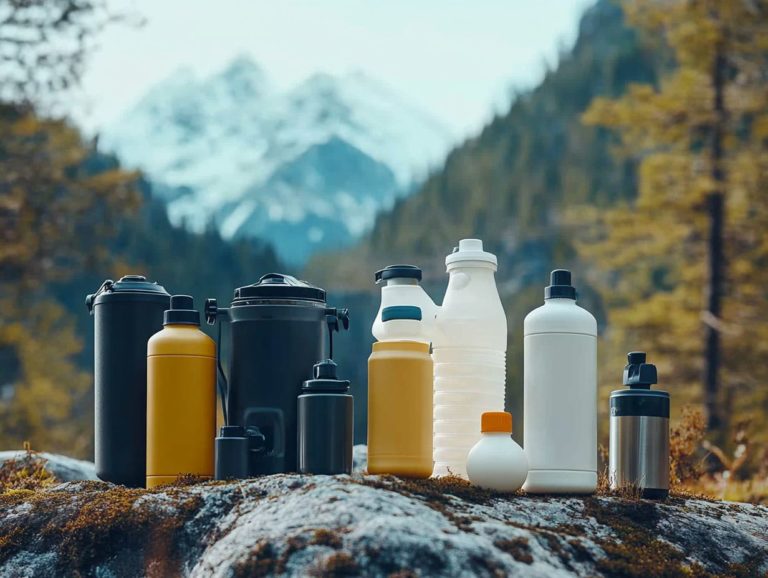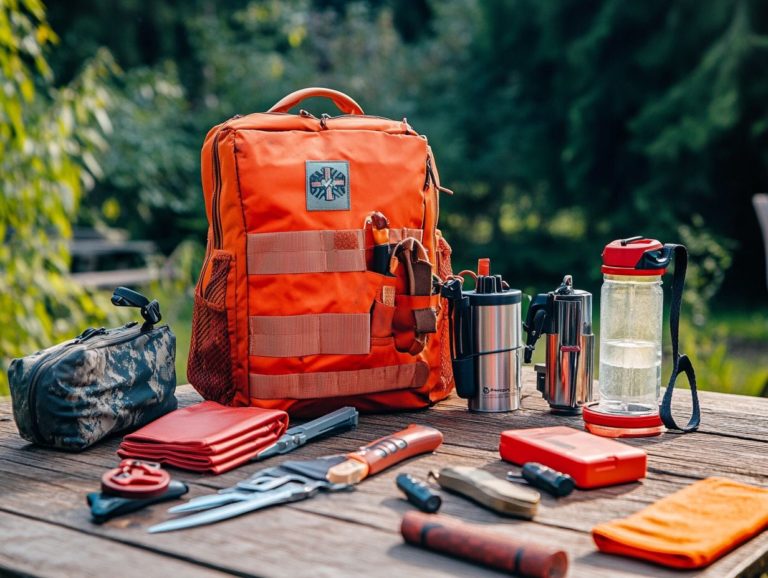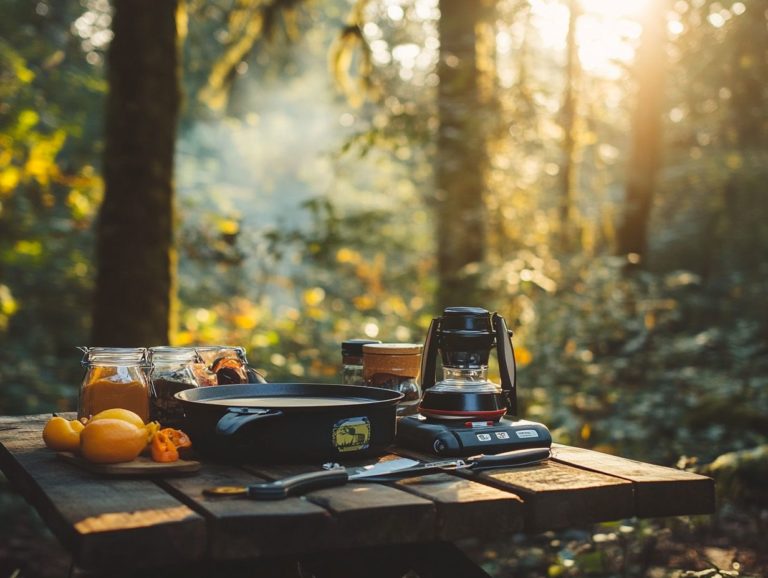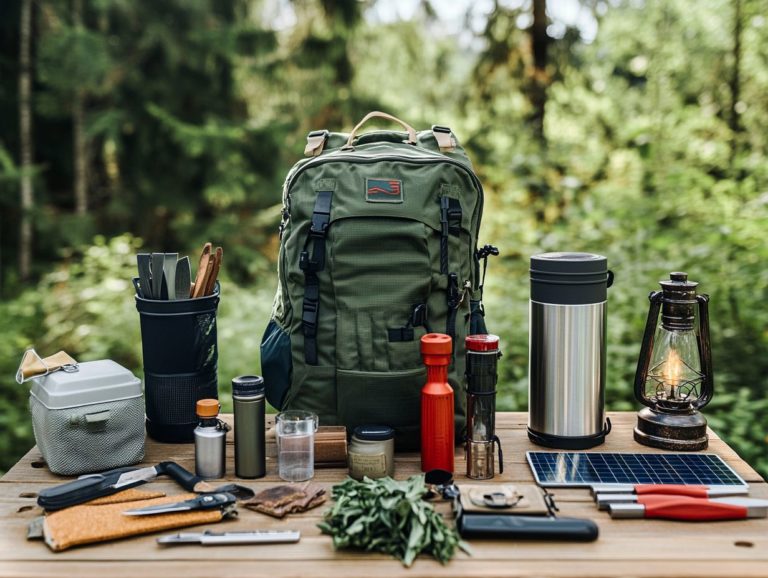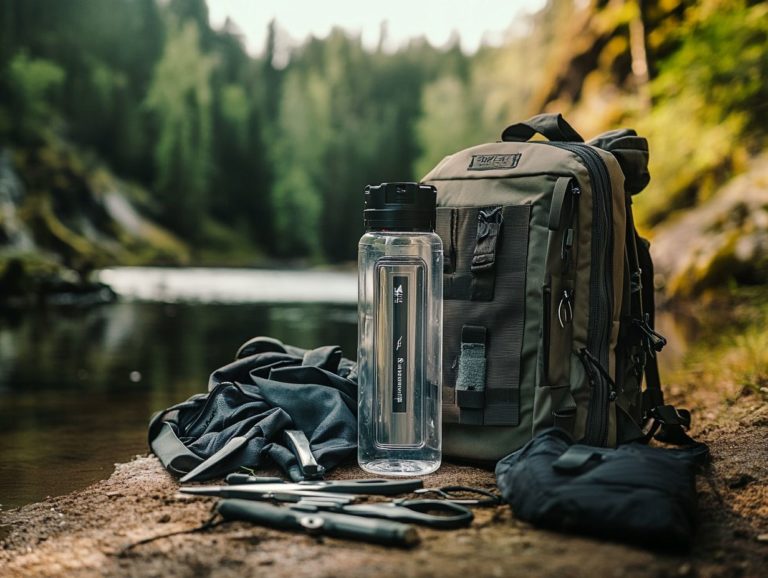The Importance of Testing Your Survival Gear
Survival gear can be your lifeline in critical situations. It s vital to ensure that everything you rely on operates at peak performance, including emergency kits and survival skills.
This article delves into the importance of rigorously testing your survival gear. We emphasize the essential items, like the 72-hour kit and bug-out bag, that deserve your attention.
You ll discover various testing methods and what to look for in your test results. Regular maintenance, including the evaluation of food storage and water purification systems, is also crucial. Equip yourself with the knowledge necessary to guarantee your gear is primed and ready when you need it most.
Contents
Key Takeaways:
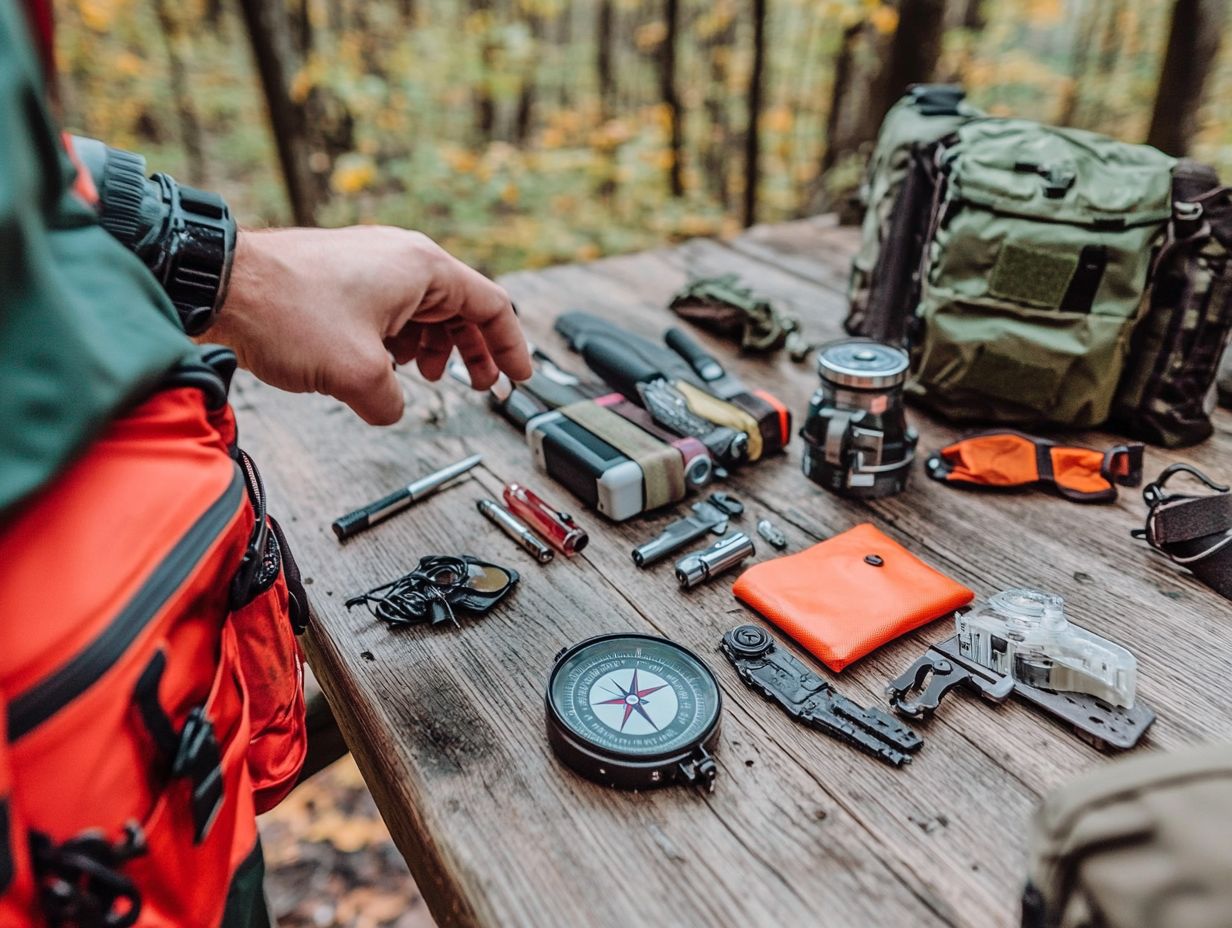
Regular testing and maintenance of survival gear, including your fire starters and medical kit, is crucial for ensuring effectiveness in emergency situations.
Key items such as shelter building, water purification, and fire-starting tools should be prioritized for testing to ensure reliability.
Different approaches and techniques, such as simulation, field testing, and stress testing, can be used to thoroughly test survival gear and identify weaknesses. It’s essential to consider the top features to look for in survival gear to ensure safety and effectiveness.
The Importance of Survival Gear Testing
Testing your survival gear is crucial it could be the difference between safety and disaster. It s a vital step in ensuring your emergency kits, such as the essential 72-hour kit, bug-out bag, and important supplies, like drinks and snacks, are ready for any situation you might face.
By regularly testing your gear, you build confidence in your emergency response strategies and survival skills. This practice allows you to evaluate the functionality of items like Meals Ready-to-Eat (MREs), fire starters, and medical kits. Understanding the importance of survival gear is essential for effective preparedness.
It also enhances your overall preparedness for outdoor adventures, including essential camping gear and survival techniques for potential crises. As you delve into effective methods for testing, consider the valuable lessons learned from past experiences.
These experiences can inform your planning and help you craft a comprehensive communication plan, ensuring the safety of everyone involved.
Why Testing is Necessary for Survival Gear
Testing survival gear is essential for your emergency preparedness journey. It ensures that every item, from fire starters to first aid kits and even rechargeable batteries, is ready to perform when you need it most.
When you take the time to thoroughly test your equipment, you gain peace of mind, knowing that your tools will function reliably during critical situations. This practice assures dependable performance and offers a valuable chance to refine your emergency plans, highlighting the importance of outdoor gear testing.
Understanding how to use each piece of survival gear builds your confidence, especially when gearing up for outdoor adventures that include wilderness navigation and cooking methods. This newfound confidence can significantly enhance your experience, transforming any trepidation into excitement as you embrace the great outdoors, fully prepared for whatever challenges lie ahead.
Essential Gear to Test
When preparing for emergencies, understanding which essential gear to test, such as your hiking pack and safety gear, is crucial. This knowledge can profoundly influence your survival chances in various scenarios, from natural disasters to outdoor adventures.
Key Items to Prioritize for Testing
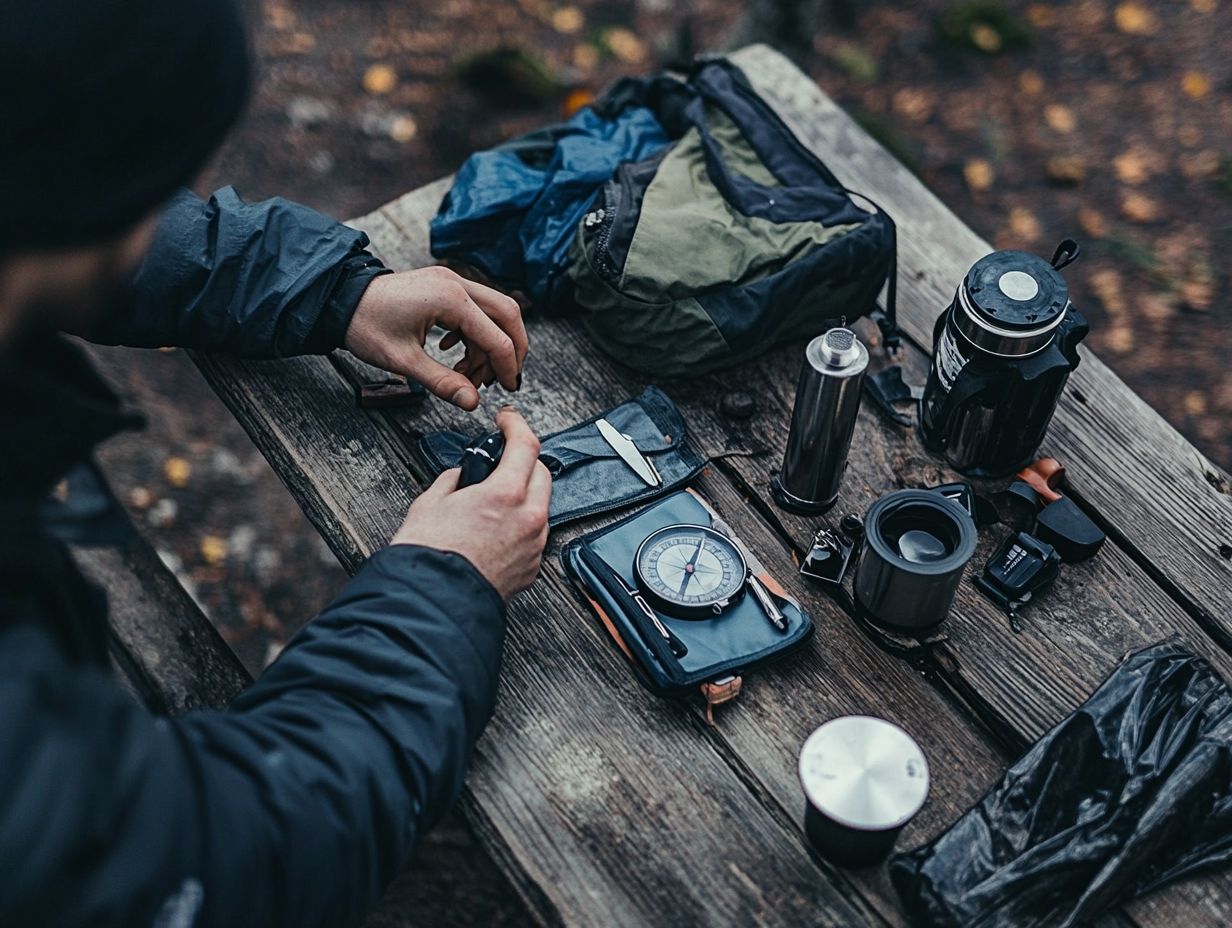
When you think about testing your outdoor survival gear, prioritize key items like emergency kits, MREs (Meals Ready-to-Eat), fire starters, and hiking packs.
These components are essential for ensuring a successful outdoor experience.
Regularly assessing these items enhances their reliability and functionality. This is crucial for effective communication during emergencies, especially when incorporating tools like communication devices and portable lights.
By checking the contents of your emergency kits such as first aid supplies and communication devices you can ensure that you’re adequately prepared for various scenarios.
Testing your MREs confirms your food supplies are still good, while reliable fire starters are a must for warmth and cooking methods when things get tough.
Don t overlook your hiking packs! Check for comfort and space to ensure they carry all your gear without becoming a burden.
These proactive measures prepare you and your family for unexpected challenges and lay a solid foundation for crisis communication plans, giving you the confidence to respond effectively when it counts.
Methods for Testing Survival Gear
Utilizing effective testing methods for survival gear is crucial to ensure that every component operates as intended. Effective testing methods include:
- Skill assessments
- Emergency drills
This diligence can significantly elevate your preparedness for a range of emergencies and outdoor situations.
Different Approaches and Techniques
Different approaches and techniques for testing survival gear encompass practical exercises that emphasize the functionality of fire starters, cooking methods, tent setup, and other essential equipment.
By immersing yourself in simulated wilderness scenarios, including survival courses, you gain firsthand experience of how your gear performs under demanding conditions. These hands-on activities provide valuable insights into your gear’s effectiveness, including items like multitools, water purification systems, and shelter materials. Understanding the importance of outdoor gear testing can further enhance your preparedness for any adventure.
Practicing under pressure boosts your confidence and sharpens your outdoor survival skills, such as wilderness navigation and teamwork, ensuring you feel prepared for emergencies. Such immersive experiences promote teamwork and problem-solving, deepening your understanding of how each piece of gear integrates into your overall survival strategy.
What to Look for in Test Results
Grasping what to look for in test results, including indicators for your gear’s functionality and safety, is crucial for making informed adjustments to your survival gear. This knowledge enables you to ensure your preparedness for any situation that may arise.
Interpreting Data and Making Adjustments
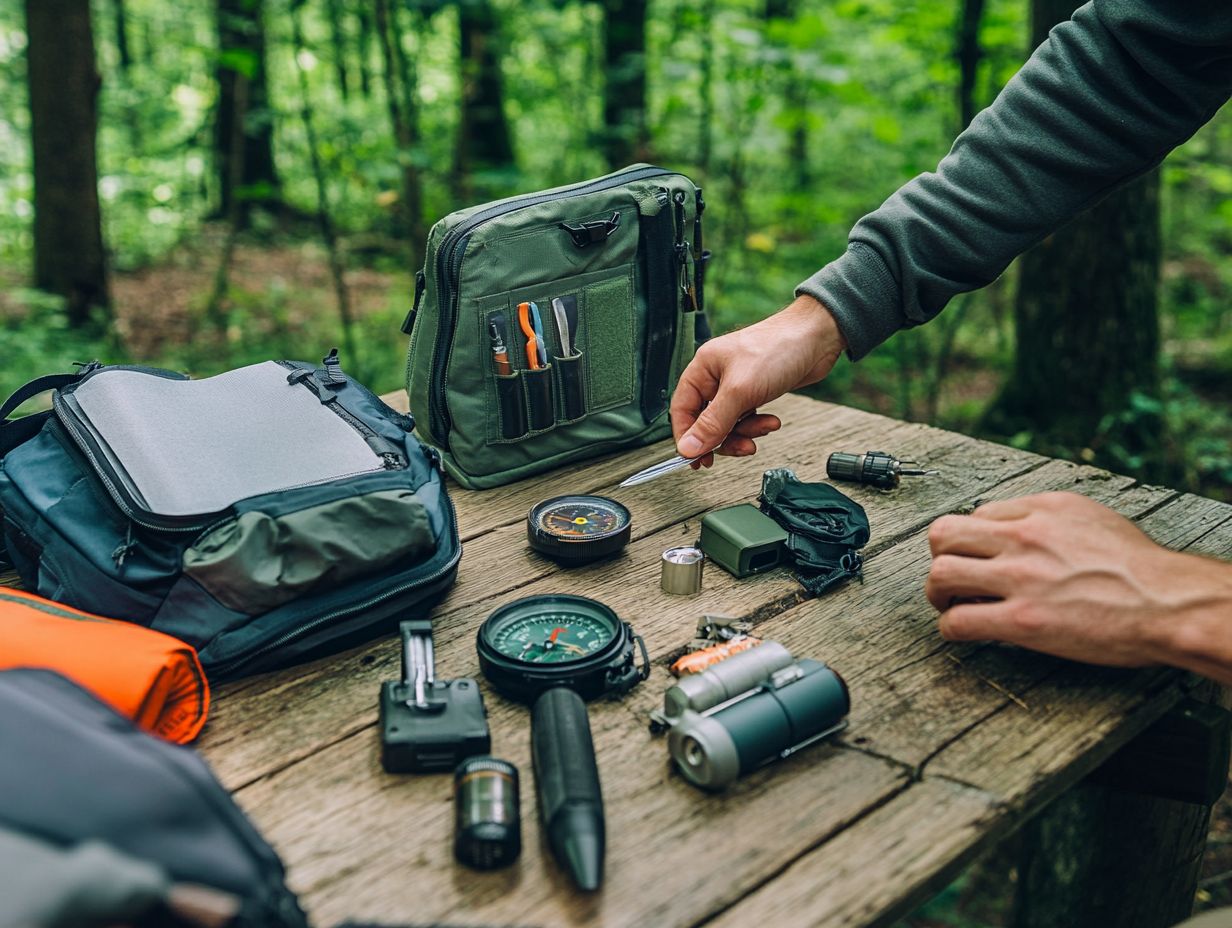
Interpreting data from gear tests enables you to make essential adjustments, a crucial step in cultivating a survival mindset and enhancing your overall preparedness for emergencies.
These adjustments not only enhance the effectiveness of your equipment but also shape the design of your strategic training sessions and crisis management plans. When you invest time in thoroughly analyzing test data, you uncover vital insights that can directly impact your emergency drill protocols.
Understanding how your gear performs across various scenarios such as power outages and physical fitness challenges ensures that you’re well-prepared for real-life situations, significantly reducing risks during emergencies. Embracing continuous improvement through iterative analysis reinforces your learning cycle, allowing you and your team to adapt to new challenges with confidence.
By connecting test data outcomes with drill performance, you bolster your operational efficiency and readiness, establishing a solid framework for effective crisis management.
Regular Testing and Maintenance
Regular testing and maintenance of your survival gear are essential to ensure that all your equipment remains functional and ready for action. This vigilance is particularly critical in critical situations, where your safety could hinge on the reliability of your gear, including your Casio watch and aluminum tent pegs.
How Often to Test and Maintain Gear
Determining how often you should test and maintain your gear, including your sports drinks and food storage options, is crucial. It can profoundly impact your survival skills and preparedness for unexpected emergencies.
Regular testing and maintenance schedules should be tailored based on several factors. These include how intensely you use your equipment, the type of gear you have, and the environmental conditions in which you plan to utilize it, such as the Sonoran Desert or during a power outage.
For example, if you re an outdoor enthusiast who frequently engages in rugged activities like hiking and camping, evaluate your gear on a monthly basis. In contrast, casual users might find that quarterly checks are more than adequate.
If your gear is exposed to harsh climates, such as during wild plant foraging expeditions, schedule more frequent inspections to guarantee its functionality. By adopting these practices, you can enhance your planning and readiness, ultimately building greater confidence in your gear’s reliability when it counts the most, especially by understanding different types of survival gear.
Frequently Asked Questions
What is the importance of testing your survival gear?
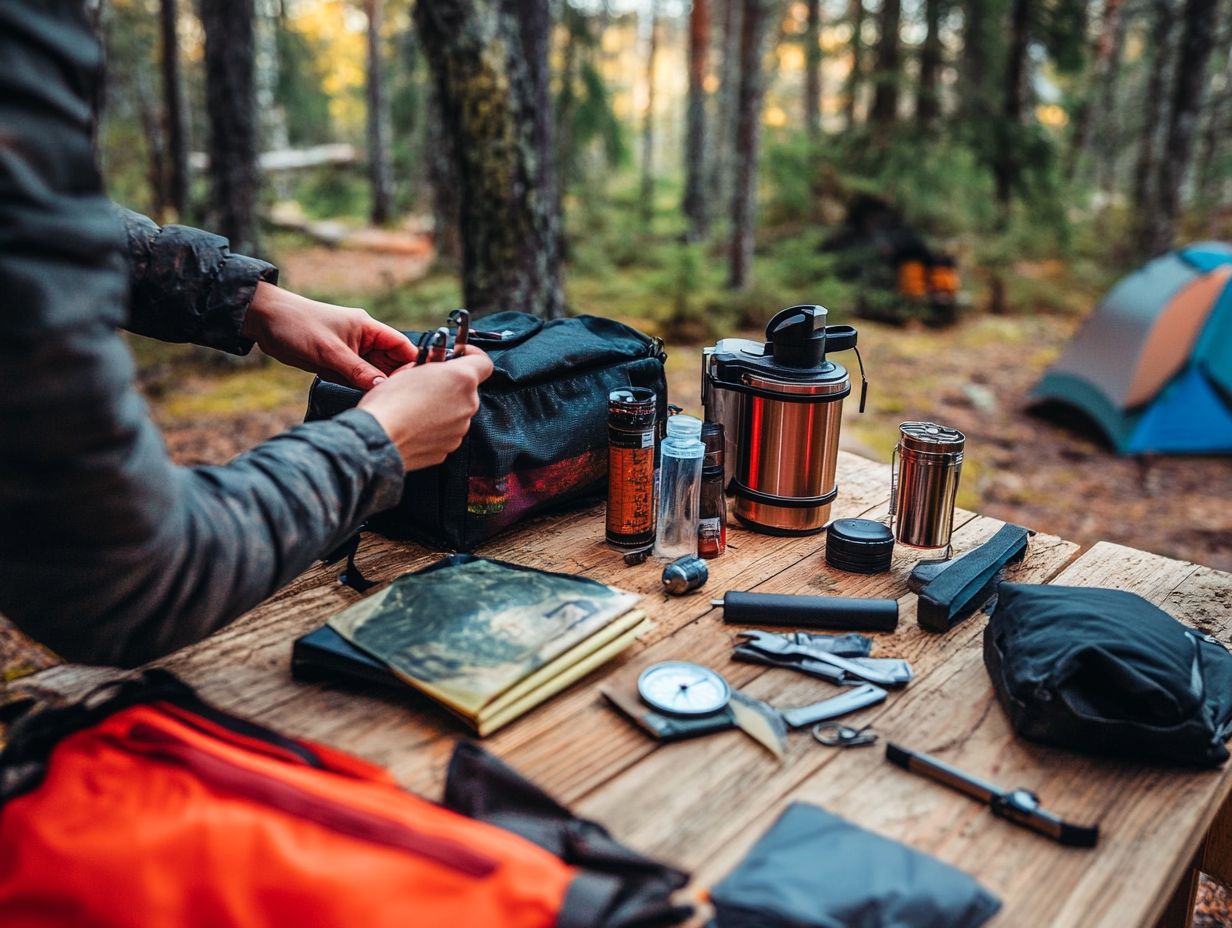
Testing your survival gear is crucial because it ensures that your equipment, including your emergency kits and survival techniques, is functional and reliable in an emergency situation. It also allows you to identify any issues or malfunctions before you actually need to use them.
How often should I test my survival gear?
It is recommended to test your survival gear, including your first aid supplies and emergency kits, at least once every six months. However, performing routine checks and maintenance on your gear is also important to ensure it is in good working condition at all times.
What should I test in my survival gear?
You should test all components of your survival gear, including your shelter, water filtration system, food supply, first aid kit, and any tools or equipment, such as your hiking pack and portable lights. It is also important to test the overall functionality of your gear, including ease of use and durability.
Can I test my gear indoors?
While it is important to test your gear in the environment you will be using it in, you can also perform indoor tests to check for basic functionality. This includes cooking methods and food preservation techniques. For example, test your water filtration system by filling it with tap water and checking if it effectively filters out impurities.
What to do if gear fails a test?
Act quickly if your gear fails a test! Address the issue immediately, which may include repairing or replacing the faulty component, or even investing in a new piece of gear. Do not rely on gear that has failed a test, as it may not be reliable in a real emergency.
How can I ensure my gear is always ready for use, including my bug-out bag?
Aside from regular testing and maintenance, store your survival gear in a cool, dry place and check it periodically to ensure it has not been damaged or compromised. Keeping a checklist of your gear and when it was last tested will help you stay organized and prepared.
Take action today! Test your gear this weekend and check your supplies now!

